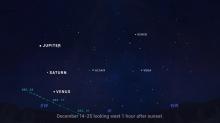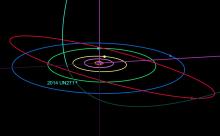Listen to today's episode of StarDate on the web the same day it airs in high-quality streaming audio without any extra ads or announcements. Choose a $8 one-month pass, or listen every day for a year for just $30.
You are here
Icy Visitor
The first known visitor from another star may be a fragment of a Pluto-like object thousands of light-years away. It lost most of its mass during its passage near the Sun in 2017, and will continue to fizzle away as it leaves the Sun behind.
‘Oumuamua was discovered in October 2017, a month after its closest approach to the Sun. As it moved away from the Sun, it sped up in a way that scientists couldn’t explain. Its motion resembled that of a comet spewing “jets” of gas into space. But astronomers didn’t see any escaping material, and the object’s composition didn’t match that of any known comets.
Last year, researchers at Arizona State found that ‘Oumuamua most likely is made of frozen nitrogen. That suggests it was knocked off the surface of an object like Pluto, whose surface is coated with nitrogen ice.
The researchers found that ‘Oumuamua could have been blasted out of its home star system — perhaps thousands of light-years away — about 500 million years ago.
As it traveled through the galaxy, cosmic rays blasted away some of its ice. It entered the solar system about 25 years ago. As it approached the Sun, solar energy vaporized more than 90 percent of its nitrogen, which jetted away into space. That whittled ‘Oumuamua down to about 140 feet long by 24 feet wide. The escaping gases gave it an extra “kick,” and also made it tumble end over end — explaining some of the odd behavior of this long-distance visitor.
Script by Damond Benningfield






